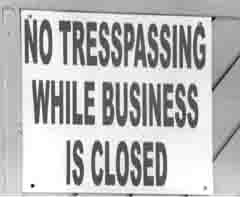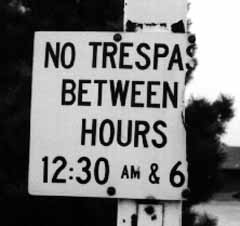| B A R E L Y B A D W E B S I T E |
|
Trespassing |
 |
This is a permanent, professionally made sign, about two feet tall by three feet wide. It's made of metal and bolted to the wall. Because of the spelling you might assume it's for a hair salon with a sense of humor, but it's not. It's for a charitable organization around here that apparently permits trespassing during business hours. |

|
This sign, one neighborhood away from mine, also allows trespassing during certain hours. |
|
|
This sign, also one neighborhood away from mine but in a different direction,
is a good example of the text-styling rule that says, "Just because you can
do it doesn't mean you should." In the second sentence we have an unusual color for such an official announcement, and we have all caps in a serif font. But the first sentence uses not one but two colors, neither of which matches the last color. Furthermore, it contains both serif and sans-serif fonts. Furthermore, it uses both all-caps and normal caps. Furthermore, it uses both a large and a small size in the first two lines. Furthermore, it uses normal and bold-face in the second two lines. And the whole thing uses a colored background. And, of course, it permits trespassing when the pool is open. Let's now discuss the subject of trespass, first with respect to crimes and second with respect to torts. Trespass is a minor crime, at least relative to breaking and entering, in which a person is on premises where he is not authorized by the owner to be. If you are found on a construction site at night and have no business being there and you're caught by the cops and especially if the owner of that property wants to press charges then -- even if you otherwise committed no crime -- you can be found guilty of trespass and fined or jailed. With respect to civil law, a trespasser is one of three classes of person, the other two being invitees and business invitees. These three classes make a difference with respect to how much care a property owner must exercise to prevent injuries. It should be pointed out that it's not just the owners per se but anyone deemed to be in "care, custody and control" who may be sued, and hereafter I'll call them defendants. The question for each of the three classes of plaintiff is the degree of the "duty of care." Trespassers are owed the least duty of care, invitees are owed a middling amount, and business invitees are owed the highest duty of care. If you get hurt and allege in a civil lawsuit that the defendants owe you money to make you whole, you don't want to have to admit you were a trespasser, because the defendants owe you less care than if you were higher on the ladder. If you are deemed by a judge or jury to have been a mere trespasser when you were hurt, the defendants have to prove only that they provided a minimal degree of care for your safety. They have to warn you, usually done with signs, that it's dangerous to enter onto the premises, and often they erect fences, such as around a construction site. But if you're a trespasser and you fall into a pit and break both legs, a jury will likely find the defendants not guilty, because they owed you such a slight duty of care. The next step up from trespasser is social invitee, because a social invitee is owed a higher duty of care than a trespasser. A social invitee is just what it sounds like, a person you invite (or merely allow) onto the property over which you have care, custody and control (but who does not rise to the level of a business invitee). If you're at your next-door neighbor's dinner party and you slip on a banana peel someone dropped an hour before and you break your hip, a jury will likely find your hosts not guilty, because they don't owe you that high a degree of care. If you're a business invitee you are owed the highest duty of care. If you operate a business such as a grocery store, your customers are business invitees in that by merely opening the doors you are asking people to come inside and shop at your business, to help you generate revenue. Even people who end up buying nothing are considered business invitees, and business invitees are owed the highest of the three levels of care. Now, for those millions of people out there who have become convinced if you suffer an injury on a store's premises the store is liable, it takes more than that. A common example will illustrate. You are walking along in the produce aisle and fail to notice a small, clear puddle of liquid on the floor. You slip on it, break your hip, run up lots of special (medical bills, for example) and general (pain and suffering, for example) damages, and sue the store for those damages. Will you win at trial? Not surprisingly, it depends. Let's say there's video of the area, supplied by the store's CCTV cameras, and let's imagine two quite different cases. Scenario 1. In the first scenario the video from two hours before your fall shows how the liquid got there: A customer dropped a lemon, it popped open, and it leaked. A few minutes later three employees and the manager herself are seen walking through the area and plainly noticing the spill. One of the employees even gets down closer to look at it. Furthermore, at the time you fell you had been looking off to your left to check the price of, well, let's say bananas. In this case you as the plaintiff have a very good case indeed, and you likely will not go to trial or even need to file a lawsuit because the insurance company will recognize that the store is legally liable to you and settle your case. That's what insurance is for. Scenario 2. In this quite different scenario the video shows the spill occurred less than a minute, not two hours, before you fell on it, and it shows that no employee was in the area during that minute. We'll assume that neither the shopper who dropped the lemon nor anyone else reported it to anyone. You slip and fall, break the same hip, incur the same damages, and sue the store for negligence (not safening the dangerous condition) and failure to warn of that dangerous condition, which actually is just a special form of negligence, (e.g., not erecting a sign warning the floor is slick). In both scenarios the store employees, who had care, custody and control over the premises, owed a high duty of care to you, a business invitee. But in the first scenario, importantly, the employees had active notice of the dangerous condition for two hours yet nothing was done to help prevent your slip and fall. Your lawyer will want to prove that the store did have notice of the condition and did have the opportunity to rectify it. After all, as in Scenario 2, if the store didn't know about the problem then it couldn't reasonably be expected to correct it. Jurors can understand that, even those jurors who walked into court the first day believing that the store will always pay. They will learn that from the store's lawyer and they will learn it from the judge in his "charge to the jury." A little side note: Tort law recognizes two types of notice, termed active notice and constructive notice. Active notice is when the defendant actually did know about the exact dangerous condition, as in Scenario 1. Constructive notice arises when the defendant merely should have known about the danger. Both types of notice are sometimes referred to by the phrase "knew or should have known." What's important to understand about constructive notice is that it's (almost) as good as active notice. Your lawyer must convince the jury the store had notice, not necessarily only active notice. If your lawyer can convince the jury that the store should have known about the unreasonably dangerous condition, even if your side stipulates that the store did not have active notice you can still prevail. Constructive notice is still notice. Presumably your lawyer would argue that the store should have patrolled the produce aisle at least once in two hours, especially since spills happen more often in the produce aisle than, say, the diaper aisle. Another little side note: You'll remember that the video shows you were looking off to the left at the time you slipped. While that fact will not reduce the store's liability to zero, an argument can be made that you are at least partly responsible. The lawyer for the store says to the jury, "Please notice that the plaintiff is not looking where she's walking, which you would especially want to do in a produce aisle, where everyone knows spills happen more often than in, say, the diaper aisle." In tort law in Illinois and many other states there's what's called contributory negligence (it's usually shortened to "contrib"), which means the jury award for full damages will be reduced by the percentage of the plaintiff's own negligence. For example, if full damages are $100,000 but the jury decides you are 20% at fault then your award will be reduced to $80,000 because of your contributory negligence. And any argument the store's lawyer would make to a jury is exactly the sort of argument claims adjusters make when negotiating with the claimant's lawyer, or with the claimant herself, the only difference being that taking advantage of an ignorant claimant is unfair whereas taking advantage of a personal injury lawyer is always not only acceptable but positively encouraged. The big insurance companies such as Liberty Mutual have firm and well-publicized policies in place that prohibit claims adjusters from treating unfairly any claimants who aren't represented by lawyers. I'd like to think claims adjusters' own moral code would make such a stated policy unnecessary.
For example, if you walk across the premises of a gas station for the sole purpose of not having to walk the long way around using the public sidewalk, you are a trespasser, which means the defendants you sue for the injuries you sustained on theor premises have to prove only that they provided a minimal degree of care. They can't dig a hole and cover it with a fake driveway and wait for you to fall in and then laugh at you, because that would be
At the top of the list are business invitees. Defendants who invite people to their premises in order to generate a profit are expected to
with respect to civil law is different. |

|
This sign states the exact hours during which trespassing is permitted. Or it did till someone, no doubt a tresspasser, smacked it in half.
The next Fun Pic is from the same shopping center. |
|
|
|
|
|
|